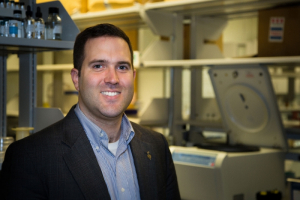A professor at the UH Cullen College of Engineering has discovered an improved method for synthesizing a zeolite structure that is more hydrothermally stable than its counterpart currently used in industrial processes.
Jeff Rimer, Ernest J. and Barbara M. Henley Assistant Professor of chemical and biomolecular engineering, published his findings in the most recent issue of the journal, Chemical Communications. His work is featured as the cover story for the journal's January issue. He conducted the research alongside his postdoc, Marlon Conato, and his graduate student, Matthew Oleksiak.
Zeolites are crystalline materials that are used as adsorbents and catalysts in a variety of chemical processes, spanning applications from gasoline production to additives for laundry detergent – not to mention thousands of other commercial and consumer products.
But despite the importance of these materials in many chemical and industrial processes, the ways in which these crystals are synthesized are not well understood. Rimer’s primary research focus is finding better ways to rationally design zeolites in order to improve the materials’ performance and reduce the costs and trial-and-error associated with their synthesis.
The typical synthesis of certain zeolite structures yields crystals made up of silicon and aluminum atoms in a one-to-one ratio. Such zeolites are particularly good adsorbents – for example, these crystals could be used to remove greenhouse gases, such as CO2, from the atmosphere.
The zeolite structure being studied in Rimer’s group, known as zeolite A (LTA type), performs very poorly as a catalyst due to its high aluminum content. In order to use this zeolite as a catalyst, researchers must improve its hydrothermal stability by increasing the silicon content in the crystal.
One way of doing this is by adding organic structure-directing agents to the growth solutions used to prepare the zeolites. However, these additives are generally expensive and the process of synthesizing zeolite structures by this route is economically infeasible, Rimer said.
Rimer’s team, then, is investigating new methods of growing these zeolite structures without the use of these organic additives.
So far, Rimer’s group has established a basic platform for conducting organic-free synthesis of many types of zeolite structures. These findings were published in the Journal of the American Chemical Society last year. While developing these models, Rimer said that his team noticed one particular “sweet spot” in their diagram where a zeolite structure with very commercially-appealing characteristics was formed.
This zeolite structure, named HOU-2, exhibits nearly twice as many silicon atoms as its more aluminous analogue zeolite A, making it a potentially far more effective catalyst. Moreover, Rimer’s team found that this zeolite structure was very stable when synthesized under certain conditions and yielded twice as many crystals as zeolite A.
Rimer’s group collaborated with Dr. Radha Motkuri, a researcher at the Pacific Northwest National Laboratory, to further investigate the gas absorption qualities of HOU-2. So far, the researchers have found that the zeolite works effectively at selectively separating CO2 from other gases. Researchers at the Pacific Northwest National Laboratory are particularly interested in the zeolite’s performance as an adsorbent for CO2 sequestration.
“We have improved the stability of these materials in a way that’s economically viable to industry and we’re using standard conditions that are very similar to what industry uses when they manufacture zeolites,” Rimer said. “This is something that could be integrated into current commercial processes very rapidly.”
